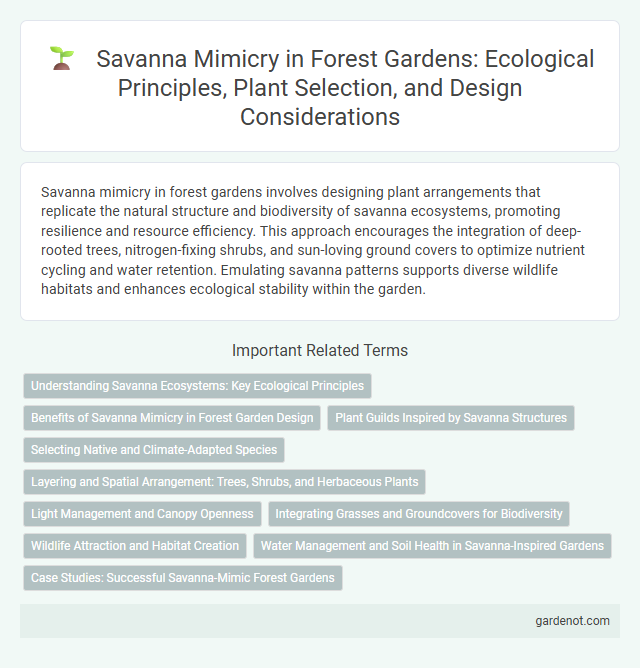Savanna mimicry in forest gardens involves designing plant arrangements that replicate the natural structure and biodiversity of savanna ecosystems, promoting resilience and resource efficiency. This approach encourages the integration of deep-rooted trees, nitrogen-fixing shrubs, and sun-loving ground covers to optimize nutrient cycling and water retention. Emulating savanna patterns supports diverse wildlife habitats and enhances ecological stability within the garden.
Understanding Savanna Ecosystems: Key Ecological Principles
Savanna ecosystems are characterized by a dynamic balance between grassy vegetation and scattered trees, driven by seasonal rainfall patterns and fire regimes. Understanding the interactions between grasses, woody plants, herbivores, and fire helps replicate these conditions in forest gardens to enhance biodiversity and resilience. Emulating savanna mimicry involves integrating species diversity and ecological processes that support nutrient cycling and habitat complexity.
Benefits of Savanna Mimicry in Forest Garden Design
Savanna mimicry in forest garden design enhances biodiversity by integrating drought-resistant grasses, scattered trees, and shrubs, replicating the natural savanna ecosystem. This approach improves soil fertility through deep-rooted plants that cycle nutrients and supports diverse wildlife habitats, promoting pollination and pest control. Incorporating savanna elements also optimizes light and water availability, fostering resilient, productive forest gardens adaptable to climate variability.
Plant Guilds Inspired by Savanna Structures
Plant guilds inspired by savanna structures optimize forest garden diversity by mimicking the layered vegetation and diverse root systems of natural savannas. Key species such as deep-rooted trees, nitrogen-fixing shrubs, and ground-cover grasses create dynamic interactions that enhance soil fertility, water retention, and microclimate regulation. This savanna mimicry approach promotes resilience and productivity in forest gardens by integrating functional plant groups that support each other's growth and ecosystem services.
Selecting Native and Climate-Adapted Species
Selecting native and climate-adapted species is crucial for successful savanna mimicry in forest gardens, ensuring plant resilience and ecological balance. Species such as longleaf pine (Pinus palustris), bluestem grasses (Andropogon gerardii), and native legumes thrive under savanna conditions, promoting biodiversity and sustainable nutrient cycling. Emphasizing drought-tolerant and fire-adapted plants enhances ecosystem stability and mimics natural savanna processes.
Layering and Spatial Arrangement: Trees, Shrubs, and Herbaceous Plants
Savanna mimicry in forest garden design emphasizes layering and spatial arrangement by integrating tall trees, mid-sized shrubs, and low herbaceous plants to replicate natural savanna ecosystems. Trees such as acacias provide canopy cover, while shrubs like wild coffee add understory complexity, and ground-level herbs including lemongrass enhance soil health and biodiversity. This stratified planting structure maximizes sunlight capture, improves nutrient cycling, and fosters habitat diversity within the forest garden.
Light Management and Canopy Openness
Savanna mimicry in forest gardens strategically manages light by replicating the open canopy structure of savannas, promoting optimal photosynthesis and understory growth. Canopy openness is maintained through selective pruning and spatial arrangement of tree species to balance sunlight penetration and shade tolerance. This approach enhances biodiversity by supporting light-dependent plants and creating microhabitats within the garden ecosystem.
Integrating Grasses and Groundcovers for Biodiversity
Savanna mimicry in forest gardens enhances biodiversity by integrating native grasses and groundcovers that replicate natural savanna ecosystems. Species such as buffalo grass (Bouteloua dactyloides) and creeping thyme (Thymus serpyllum) create layered habitats that support pollinators, soil microbes, and beneficial insects. This groundcover strategy promotes soil health through erosion control and nutrient cycling, fostering resilient, diverse plant communities.
Wildlife Attraction and Habitat Creation
Savanna mimicry in forest gardens enhances wildlife attraction by replicating the diverse plant structures and open canopy typical of natural savannas, providing food sources and shelter for a wide range of species. This habitat creation supports pollinators, birds, and small mammals by offering nesting sites and seasonal resources that sustain biodiversity year-round. Integrating native grasses, flowering shrubs, and scattered trees fosters a dynamic ecosystem that encourages ecological balance and resilience.
Water Management and Soil Health in Savanna-Inspired Gardens
Savanna mimicry in forest gardens enhances water management by optimizing rainfall infiltration through deep-rooted native grasses and scattered tree canopies, reducing runoff and soil erosion. The diverse plant layers promote soil health by increasing organic matter and microbial activity, fostering nutrient cycling and improving soil structure. Integrating savanna species with adaptive traits supports moisture retention and resilience against drought in garden ecosystems.
Case Studies: Successful Savanna-Mimic Forest Gardens
Savanna-mimic forest gardens replicate the dynamic structure and biodiversity of natural savannas by integrating drought-tolerant trees, perennial grasses, and nitrogen-fixing plants to enhance soil fertility and resilience. Case studies from East Africa demonstrate that incorporating native Acacia species with staple crops like millet and sorghum improves yield stability and biodiversity while supporting local livelihoods. These designs promote sustainable agroforestry by balancing open canopy layers with diverse understory vegetation, fostering ecosystem services such as carbon sequestration and habitat provision.
Savanna mimicry Infographic

 gardenot.com
gardenot.com